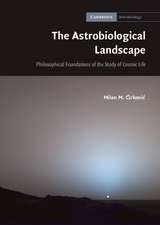Factor Separation in the Atmosphere: Applications and Future Prospects
Editat de Pinhas Alpert, Tatiana Sholokhmanen Limba Engleză Hardback – 9 feb 2011
Preț: 786.62 lei
Preț vechi: 914.68 lei
-14% Nou
Puncte Express: 1180
Preț estimativ în valută:
150.54€ • 156.96$ • 125.11£
150.54€ • 156.96$ • 125.11£
Carte tipărită la comandă
Livrare economică 20 martie-03 aprilie
Preluare comenzi: 021 569.72.76
Specificații
ISBN-13: 9780521191739
ISBN-10: 0521191734
Pagini: 292
Ilustrații: 76 b/w illus. 15 colour illus. 36 tables
Dimensiuni: 179 x 254 x 19 mm
Greutate: 0.74 kg
Editura: Cambridge University Press
Colecția Cambridge University Press
Locul publicării:Cambridge, United Kingdom
ISBN-10: 0521191734
Pagini: 292
Ilustrații: 76 b/w illus. 15 colour illus. 36 tables
Dimensiuni: 179 x 254 x 19 mm
Greutate: 0.74 kg
Editura: Cambridge University Press
Colecția Cambridge University Press
Locul publicării:Cambridge, United Kingdom
Cuprins
1. Introduction Pinhas Alpert; 2. The Factor Separation method and the fractional approach Pinhas Alpert and Tatiana Sholokhman; 3. Investigation of the FS features for basic mathematical functions Pinhas Alpert and Tatiana Sholokhman; 4. Factor Separation and paleoclimates André Berger, Martin Claussen and Qiuzhen Yin; 5. Meso-meteorology: Factor Separation examples in atmospheric meso-scale motions Pinhas Alpert; 6. Using the Factor Separation method for land-use land-cover change impacts on weather and climate process with the Regional Atmospheric Modeling System Adriana Beltrán-Przekurat, Roger A. Piekle, Sr, Joseph L. Eastman, Gemma T. Narisma, A. J. Pitman, Ming Lei and Dev Niyogi; 7. Application of Factor Separation to heavy rainfall and cyclogenesis: Mediterranean examples Romu Romero; 8. Experience in applying Factor Separation analysis to assessing urban land-use and aerosol impacts on precipitation Susan C. van den Heever, Christopher M. Rozoff and William R. Cotton; 9. Free and forced thermocline oscillations in Lake Tanganyika Olivier Gourgue, Eric Deleersnijder, Vincent Legat, Emmanuel Marchal and Laurent White; 10. Application of the Factor Separation method to quantify the effect of waste heat, vapour and pollution on cumulus convection Gerhard W. Reuter; 11. The use of Factor Separation method for climate variable interaction studies in hydrological land surface models and crop yield models Dev Niyogi, R. Mera, Yongkang Xue, G. Wilkerson and F. Booker; 12. Linear model for the sea breeze Tatiana Sholokhman and Pinhas Alpert; 13. Experience and conclusions from the Factor Separation method: ensemble data assimilation and forecasting applications Dorita Rostkier-Edelstein and Joshua P. Hacker; 14. Tagging systematic errors arising from different components of dynamics and physics in forecast models T. N. Krishnamurti and Vinay Kumar; 15. Some difficulties and prospects Pinhas Alpert and Tatiana Sholokhman; 16. Summary Pinhas Alpert; Index.
Descriere
Provides a comprehensive description of novel approach to separate contributions from several factors in any dynamical process in the atmosphere.












